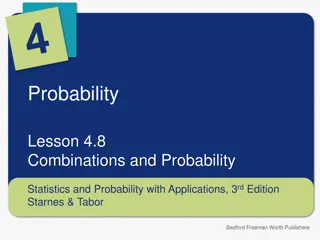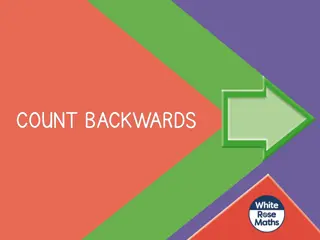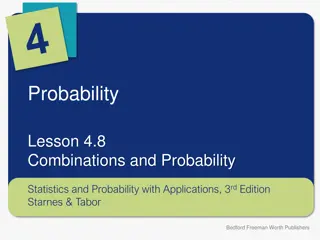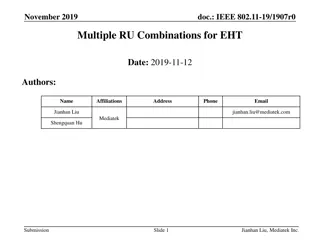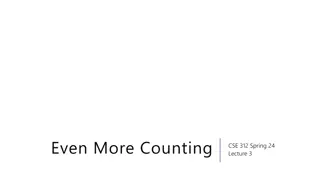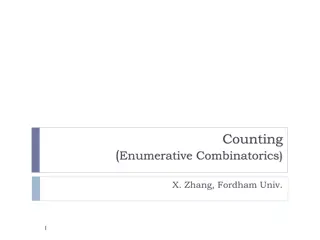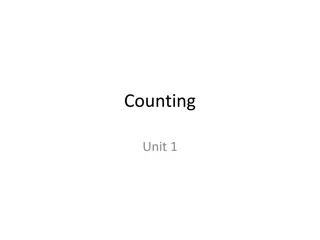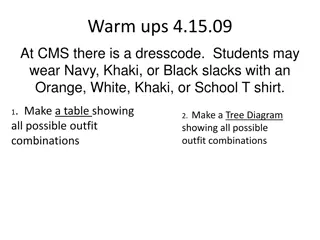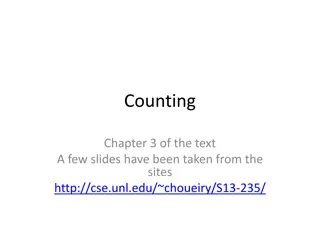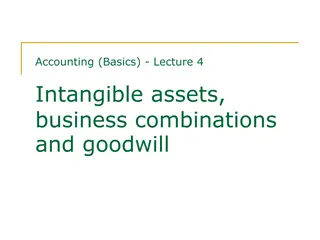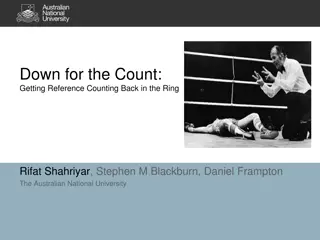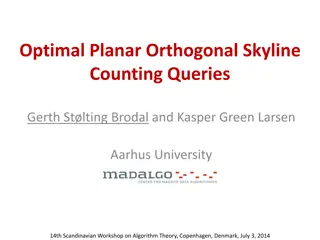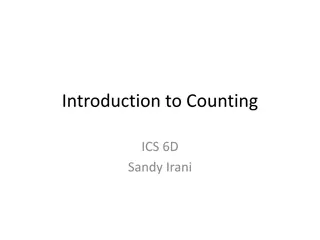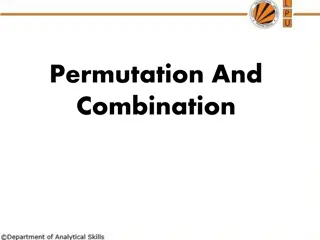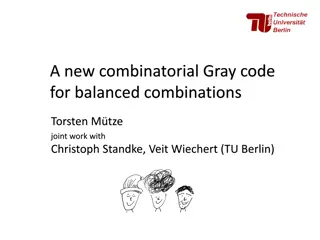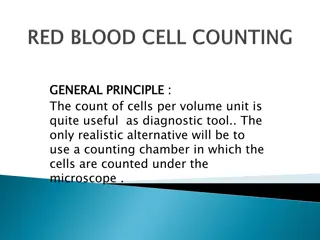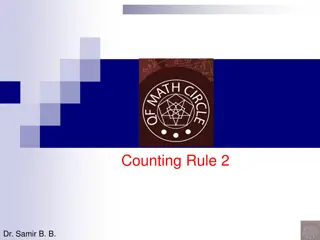Understanding Combinations and Counting Techniques
Combinations play a crucial role in counting techniques, where subsets of elements are selected without regard for the order. This text explores the concept of combinations, including calculating the number of possible combinations, distinguishing between unordered and ordered selections, and providing examples to illustrate the application of combinations in various scenarios.
Download Presentation

Please find below an Image/Link to download the presentation.
The content on the website is provided AS IS for your information and personal use only. It may not be sold, licensed, or shared on other websites without obtaining consent from the author. Download presentation by click this link. If you encounter any issues during the download, it is possible that the publisher has removed the file from their server.
E N D
Presentation Transcript
Counting Techniques: Combinations 1
Combinations Typical situation: How many 5-card hands can be made from a deck of 52 cards? Definition: r-combination of a set of n elements is a subset of r of the n elements. The number of all r-combinations of a set of n elements denoted and read n choose r . n , ( , ), C n r C , n r r In the example above, want to find C52,5 . 2
Unordered versus ordered selections Two ordered selections are the same if the elements chosen are the same; the elements chosen are in the same order. Ordered selections correspond to r-permutations. The number of all r-permutations is P(n,r) . Two unordered selections are the same if the elements chosen are the same. (regardless of the order in which the elements are chosen) Unordered selections correspond to r-combinations. The number of all r-combinations is C(n,r) . 3
Formula for computing C(n,r) Suppose we want to compute P(n,r) . Constructing an r-permutation from a set of n elements can be thought as a 2-step process: Step 1: Choose a subset of r elements; Step 2: Choose an ordering of the r-element subset. Step 1 can be done in C(n,r) different ways. Step 2 can be done in r! different ways. (regardless of how the step 1 was performed) Based on the multiplication rule, P(n,r) = C(n, r) r! Thus, ) , ( ) , ( r r ! P n r n = = C n r ! ! ( )! n r 4
Examples on Combinations The number of different 5-card hands from a deck of 52 cards: 52 ! 52 51 50 49 48 = = = 52 ( ) 5 , , 2 598 960 , C ! 5 47 ! 1 2 3 4 5 4 members from a group of 11 are supposed to work as a team on a project. Q: How many distinct 4-person teams can be chosen? A: 2 1 ! 7 ! 4 11 ! 11 10 9 8 = = = 11 ( ) 4 , 330 C 3 4 5
Examples on Combinations Suppose in the project example, Mary might work on the project only if John is also involved in the project. Q: What is the number of 4-people teams that can be chosen from 11 people in this case? Solution: Divide the set S of all possible teams into two subsets. Let X be the set of teams with Mary; Y be the set of teams without Mary. If Mary is in the team, then John is also there. The remaining 2 spots should be filled by the other 9 members. Thus, n(X) = C(9, 2) = 9 8 / 2 = 36 . Suppose Mary is not in the team. Then any of the other 10 members can fill the 4 spots. Thus, n(Y) = C(10, 4) = (10 9 8 7) / (1 2 3 4) = 210 . Based on the addition rule, n(S) = n(X) + n(Y) = 36+210 = 246
Examples on Combinations Suppose that 3 cars in a production run of 40 are defective. A sample of 4 is to be selected to be checked for defects. Questions: 1) How many different samples can be chosen? 2) How many samples will contain exactly one defective car? 3) What is the probability that a randomly chosen sample will contain exactly one defective car? 4) How many samples will contain at least one defective car? Solution: 1) C(40, 4) = (40 39 38 37) / (1 2 3 4) = 91,390 7
Examples on Combinations 2) How many samples will contain exactly one defective car? Think of selecting a sample as a 2-step process: Step 1: Choose the defective cars; Step 2: Choose the good cars. There are C(3,1) ways to choose 1 defective car. There are C(37,3) ways to choose 3 good cars. By the multiplication rule, the number of samples containing exactly 1 defective car is C(3,1) C(37,3) = 3 (37 36 35) / (1 2 3) = 23,310 3) What is the probability that a randomly chosen sample will contain exactly one defective car? The probability = 23,310 / 91,390 = .255 8
Examples on Combinations 4) How many samples will contain at least one defective car? There are 2 ways to answer this question, either by the addition rule or by the difference rule. The solution by the difference rule is less intuitive but shorter. Let s solve it by the difference rule. (# of samples with 1 defective cars) = (all possible samples) (# of samples with no defective cars) . But (# of samples with no defective cars) = (# of samples with only good cars) = C(37,4)=66,045 Thus, (# of samples with 1 defective cars) = 91,390 66,045 = 25,345 9
Some Advice about Counting Apply the multiplication rule if The elements to be counted can be obtained through a multistep process; Each step is performed in a fixed number of ways regardless of how preceding steps were performed. Apply the addition rule if The set of elements to be counted can be broken up into disjoint subsets. Note: Often a counting problem is solved by applying both the multiplication and addition rules (and their variations) at different stages of the solution. 10
Some Advice about Counting In any counting problem, make sure that 1) every element is counted; 2) no element is counted more than once. When using the multiplication rule, these directives become: 1) every outcome should appear as some branch of tree; 2) no outcome should appear on more than one branch of tree. When using the addition rule, the directives become: 1) every outcome should be in some subset; 2) the subsets should be disjoint. (avoid double counting) 11



